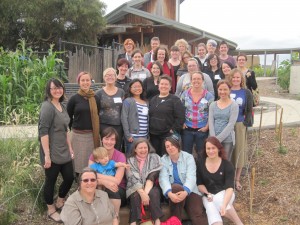This is a recap of my second day at AdaCamp. My second post in this series was about day 1.
Diversity beyond gender
My first session of the day was about creating welcoming spaces that encourage all kinds of diversity, rather than only focusing on gender. Those present were very interested in physical space issues involving hacker/maker spaces or running events. We discussed a set of practices that have worked in several spaces:
- Let the people involved set the agenda and define the uses of a space.
- Create an environment where a person of color is not the only person of color when they walk in.
- Describe a space as a “makerspace” rather than a “hackerspace”.
- Make events invite-only to establish a welcoming culture.
- Don’t say “please come if you are a woman”. This is tokenizing language that discourages participation.
- Invite everyone to organize events, not just attend events.
- Invite people to events through existing, established groups.
- Spend time thinking about who and what is missing from a group or space and take action to fix or change.
Patterns of exclusion start long before we deal with them in technology culture.
Being feminine in tech
This was a very large group, so we attempted to focus discussion on some key issues. I was also reminded of “grunch“, the feeling you get when you’ve suddenly been reminded that you’ve got a feminine body.
Our initial set of discussion topics were:
- Masculinity valued over femininity — how do we get to express a masculine identity in an authentic way and not devalue femininity? Are we expressing masculinity because it’s who we are or because we perceive it as having more value?
- How “woman” can I be? do I have to switch to their language? what rules do I have follow?
- How do I make suggestions for a more gender neutral culture in the workplace?
- Peer shaming if you represent as highly feminine or androgynous
- Reacting to the hyper masculine by occupying a more feminine place despite its authenticity
Participants shared a series of stories about their experiences expressing feminine or masculine dress, haircut, physical attributes. Most of the descriptions were posed as experiments — “I spent a month wearing dresses to normalize femininity in my workplace and here’s what happened.” The experiments women are running on themselves and their coworkers to try to get people used to women in the workplace are fascinating and shocking. Reflecting on the discussion, I felt like we were back in pre-women’s suffrage, where men were shocked at women working or wanting equal rights.
I also realized that I think about issues with what I wear a lot, but rarely talk about it with my colleagues.
I learned about differentiating between a few different concepts when talking about expressing femininity:
- Gender policing: comments designed to inform someone that they’re violating an accepted norm. Examples include being described as “dressing too slutty”, aggressive attention when a woman has a shaved head and looks masculine or androgynous.
- Masculine assimilation: dressing more masculine to avoid unwanted attention
- Feminine presentation seen as inviting sexual attention: several people described a dramatic change in behavior among colleagues or students when women wore traditionally feminine clothing (skirts, dresses, blouses)
- Peer shaming: in this context, we discussed concerns with women who shame other women over appearing/acting too feminine, or using feminine symbols like the color pink.
There was a lot more to this conversation. Looking back over the notes, I am a bit overwhelmed at how much ground we covered among so many people in just an hour. This session also led to some other hallway track conversations where I learned a bit more about how individuals are trying to balance their activism with their personal relationships with other women in open source/hardware/culture communities.
Hardware hacking!
I spent some time with the hardware hackers. Several women brought soft circuits, and one person brought a soldering station so that people could try out soldering for the first time. I was trying to get some IR LEDs integrated into a headband, and we had some issues with the shape and the stretchiness of our material. Other folks at the table were making blinking fuzzy muppet/monsters for their badges. Lots of very adorable blinky things were assembled.
I did demonstrate how to troubleshoot LEDs and what IR light looks like on digital cameras. I talked a bit more about medical devices with someone looking into how to hack her own augmentations. It felt a little like a “from the future” conversation. 🙂
Mozilla contributor dinner
I spent Sunday evening having dinner with some Mozilla contributors from France and a couple coworkers. I was probably the only person at the table who spoke only English, reminding me that I really aught to keep up on my language lessons. 😀
I caught my buddy Diane up on what had happened at AdaCamp, met Delphine’s husband and tried to convince some contributors to lead an effort to have an AdaCamp in Europe!
By the end of the evening, I was ready to collapse and get back to Portland!
Summing up
My last post about AdaCamp will be reflecting on all three of the camps – starting in Melbourne, Australia, then Washington, DC and finally in San Francisco. The event has grown from about 40 people to 200+, and for me, is the most exciting gathering of women in open source, open hardware and open culture. I’ve never been around so many women who share the same values, who are fighting for openness in technology and who are focused on tearing down the many barriers we face to involving more women in our technical communities.

